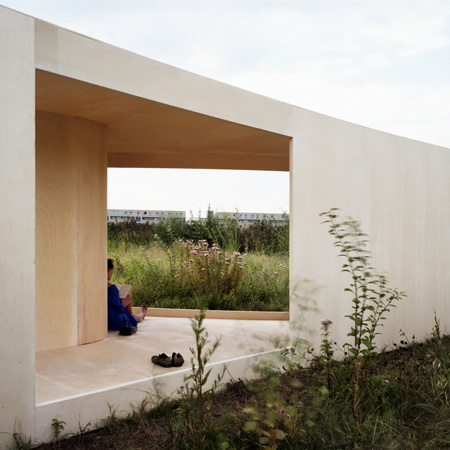Dutch architect Anne Holtrop has completed a pavilion in an overgrown field in Almere, Netherlands, with plans that follow existing trails and paths across the site.
Called Trail House, the structure begins as an extension of the paths and features the same curvature of the trails, getting wider at certain parts and dividing in other places.
Apertures in the façade provide views out to the landscape.
Photographs are by Bas Princen.
Here's some more information from the architect:
Trail House introduction
Trail House is a single house with a fragment of the existing paths (or trails) as the plan for the house. A house with the same curvature as a path, a house that curls, bends and split through the landscape. The plan, as an objet trouvé of a landscape element, has defined characteristics without being formed by its architectural function. A curvature, a dead end, a bifurcation, all are special spaces with its relations to the landscape.
‘We live in space, in these spaces, these towns, this countryside, these corridors, these parks. That seems obvious to us. Perhaps indeed it should be obvious. But it isn’t obvious, not just a matter of course [....] There’s nothing, for example, to stop us from imagining things that are neither towns nor countryside (nor suburbs), or Métro corridors that are at the same time public parks. Nor anything to forbid us imagining a Métro in the heart of the countryside.’
Georges Perec, Species of spaces and other pieces, 1997 (translation of Espèces d’Espaces, 1974)
SITE2F7 is a largely vacant and as yet unplanned site in the centre of the city of Almere. Everything there is temporary. There are wild orchids, including the Southern Marsh Orchid which is listed in the Netherlands as an endangered plant species. There are countless grasses, herbs, flowers and willows. There are White and Yellow Sweet Clover; Black Medick; Bird’s-Foot, Hop and Lesser Hop Trefoil; and Red, White and Alsike Clover. There are artificial sand hills, some of them overgrown. There is a bridge over a ditch, made out of an old mattress with a wooden pallet on top of it. There is a small mowed football pitch with goalposts made of blue-painted tubular steel and two wooden benches with concrete bases. There is a field with sorrel growing up out of the grass, and in the background a rectangular block of houses whose small gardens extend to just one metre in front of the façades. There are two roads, a cycle path, a ditch and a railway alongside it, with an office block under construction behind them. There are paths across the site, worn down out of the vegetation, with sometimes very clear and sometimes barely visible branches, bends, forks, shifts and cut-offs. The paths intersect and link the elements of the vacant site. They turn it into a landscape. Path and site go hand in hand.
Click for larger image
What if some of these paths formed a house? You are walking through the landscape among all the plants, grasses and other elements, and then suddenly, without any warning, the house begins as an extension of the path. Once inside, the space carries on with the same curvature as it had outside just a moment ago, and gradually widens. The walls, floor and roof invert the path, as though you’ve ended up in it. On the left an opening in the wall with a view of an open space, and on the right a bulge in the wall where the house divides into two separate parts – just like a path. One of the parts carries on, and on one sharp bend you come across the kitchen and on a following bend a table and chairs. You pass alternating short and long windows through which other parts of the house can be seen among the vegetation. Hanging in a tiny, narrow, winding space is a trail of vests, trousers, shirts, dresses, jackets and scarves leading towards the bed. Then the house continues on its way and finally stops at the bath, at the end of a long, curved space, and before you get there you first come across the washbasin, then the toilet and only then the bath with the view of the continuing path. From the bath, diagonally to the left, the other fork of the house can be seen.
This is the Trail House.
Extra information: Trail House is part of the exhibition Unknown Territories 2009 by Museum De Paviljoens in Almere
Architecture: Anne Holtrop, Amsterdam
Commissioned by: Museum De Paviljoens, Almere
Photos Trail House: Bas Princen, Rotterdam
See also:
.
| Floating gardens by Anne Holtrop | Elm & Willow House by Architects EAT | More architecture stories |

